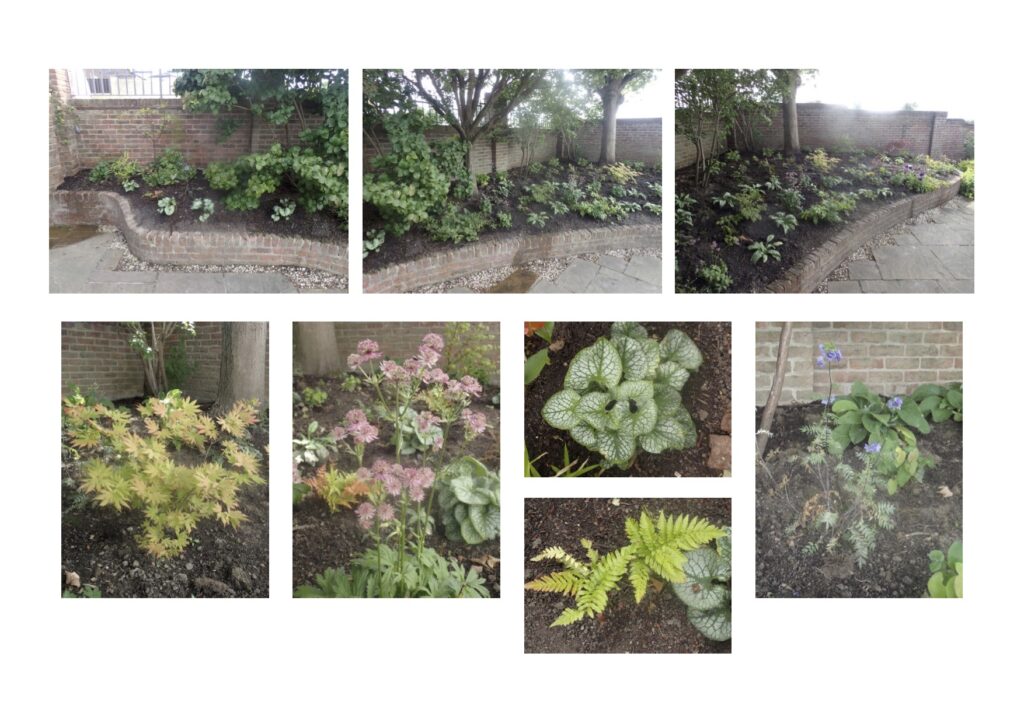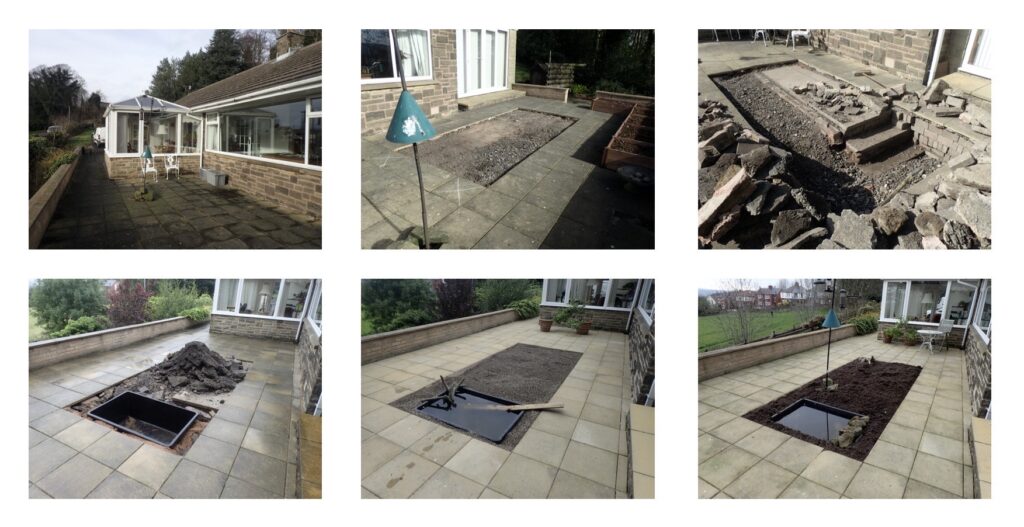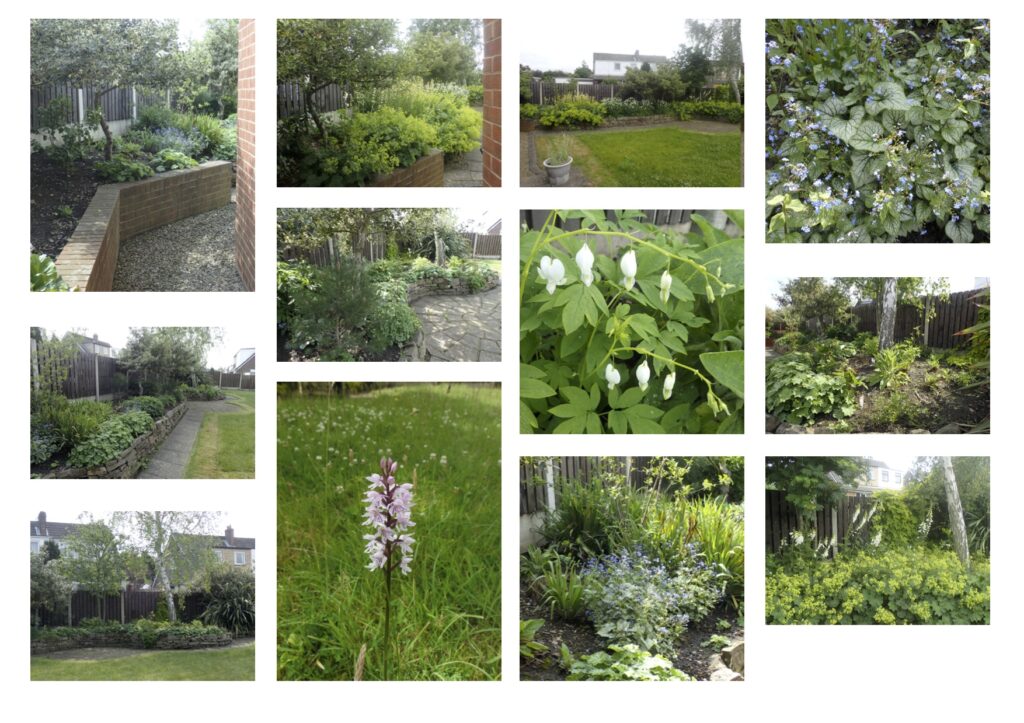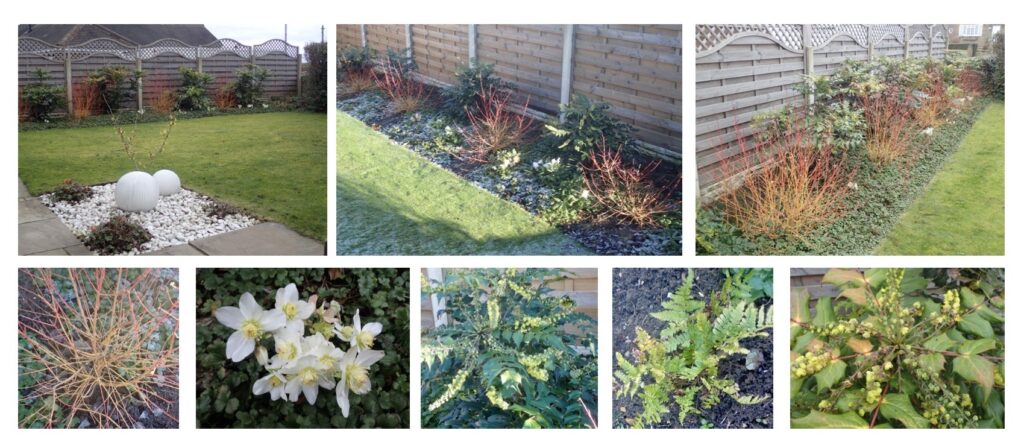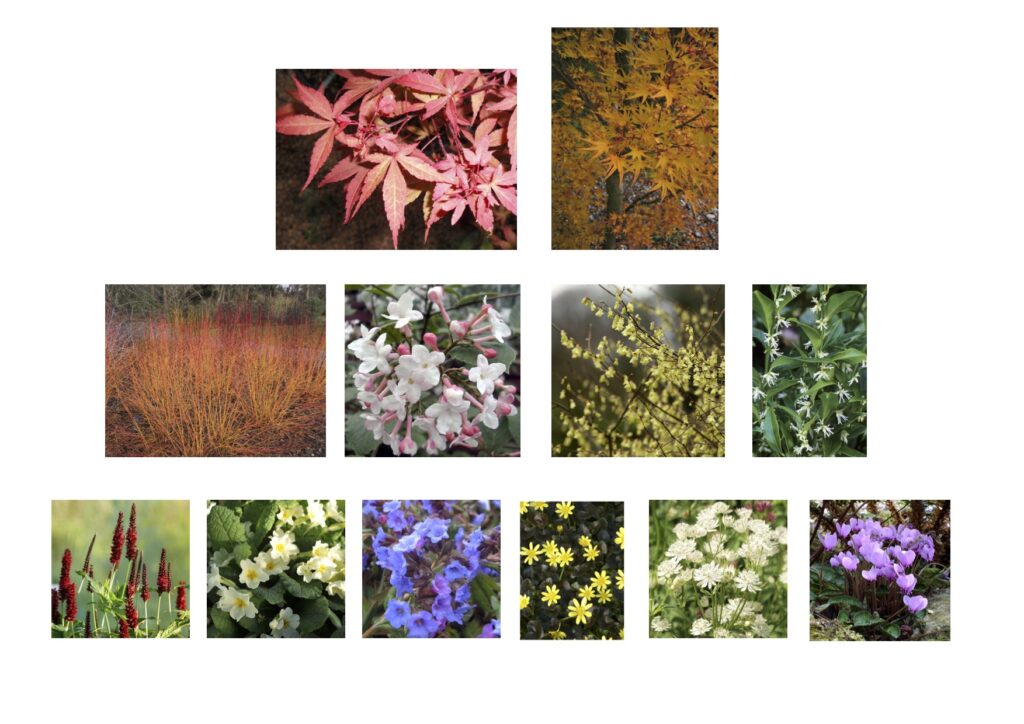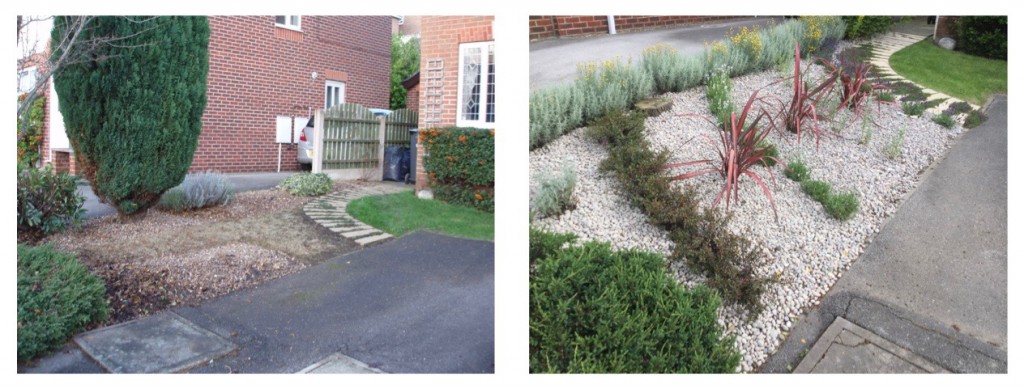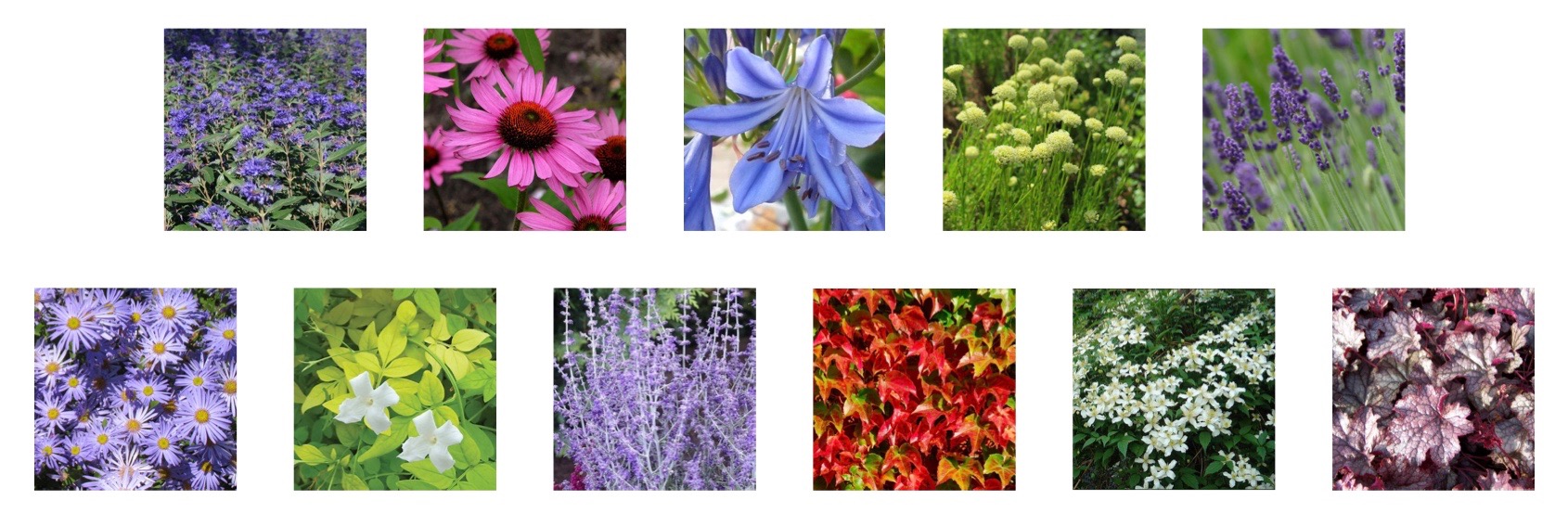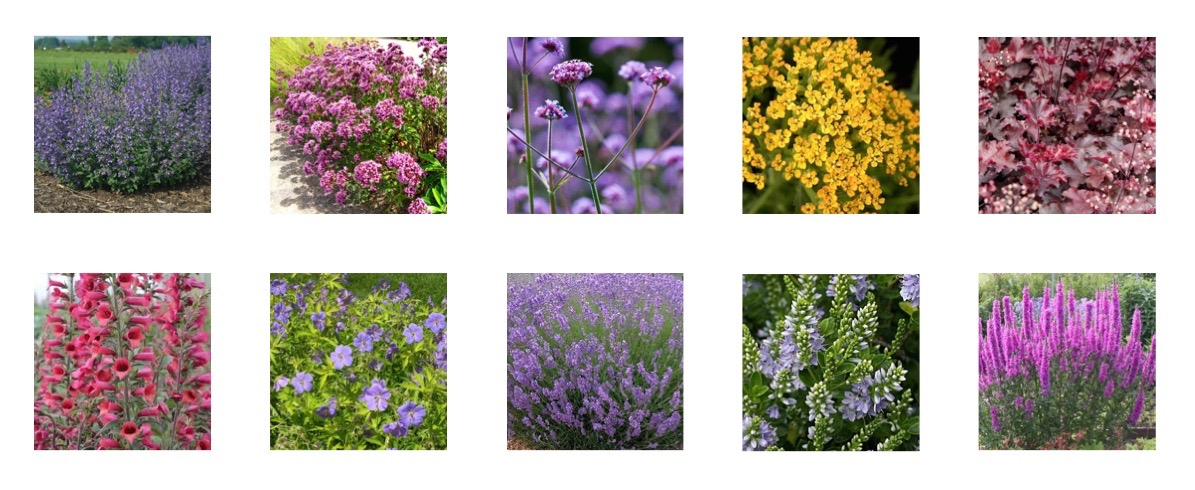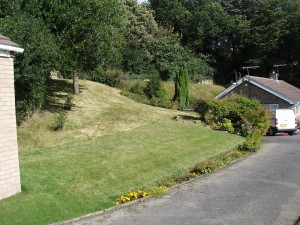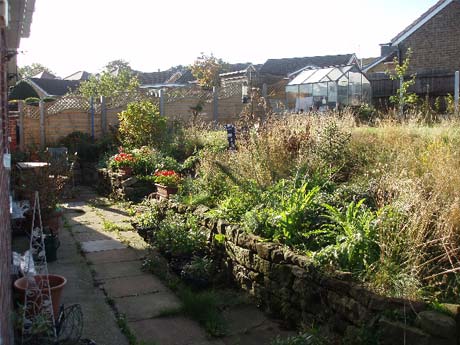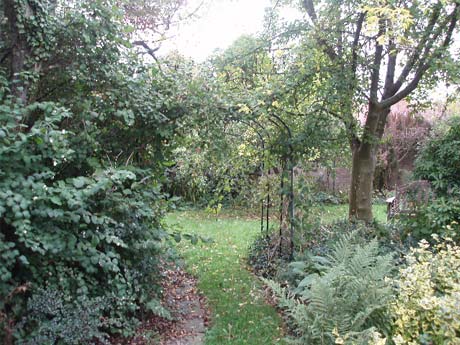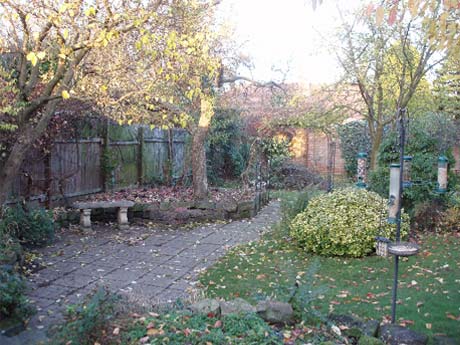Gallery
Instagram Feed
Error: No feed found.
Please go to the Instagram Feed settings page to create a feed.
Small town garden
A small town garden renovation. Works included removing an existing pond, installation of climbing plant supporting wires, new stepping stones, soiling and re-turfing, installation of steel lawn edging, removal of existing shrubs and re-planting with a small tree, shrubs, herbaceous perennials, a thyme lawn and bulbs. End result shown above immediately after planting. Process shown below, including planting plan on rhs. (Click on images to magnify.)
Tree – Malus ‘Scrumptious’; shrubs – 3 no. Daphne ‘Eternal Fragrance’, 3 no. Sarcococca humilis; climbers – Clematis ‘Warsaw Nike’, Rosa ‘Claire Austin’; herbaceous perennials – 3 no. Alchemilla mollis, 6 no. Delphinium ‘Summer Skies’, 1 no. Echinacea ‘Green Jewel’, 1 no Aster ‘Ezo Murazaki’, 3 no. Salvia ‘Amistad, 3 no. Phlox ‘Fujiyama’, 1 no. Aster veilchenkonigin’, 3 no. Lupinus ‘Polar Princess’, 5 no. Aquilega ‘Ruby Port’, 3 no. Geranium ‘Rozanne’, 3 no. Campanula ‘Pritchard’s Variety’, 5 no. Digitalis purpurea ‘Alba’, 3 no. Iris ‘Black Swan’; ferns – 3 no. Polystichum; bulbs – 9 no. Narcissus ‘Lemon Drops’ and snowdrops (re-planted from original garden).
Spring/woodland border
A spring/woodland border building upon existing trees and shrubs. After some formative pruning to the existing plants additional trees and shrubs were added – two Japanese Acers, namely ‘Autumn Moon’ and ‘Crimson Queen’; one dwarf Spindle tree (Euonymus alatus compactus); and one Winter Hazel (Corylopsis pauciflora). A layer of perennials and ferns was then added – 13 no. Astrantia ‘Buckland’; 13 no. Brunnera ‘Jack Frost; 13 no. Digitalis ‘Alba’ (Foxglove); 9 no. Dryopteris erythrosora; 13 no. Epimedium ‘Niveum’; 13 no. Polemonium ‘Bressinham Purple’ (Jacob’s Ladder) and 13 no. Pulmonaria ‘Opal’ and 25 no. Primula vulgaris (native Primrose).
Small pond
This customer’s garden is on a steeply sloping hillside. We’ve always wanted to introduce a pond into the garden as much of the garden is managed to encourage wildlife. In the end we decided the only place to add water was by inserting a pond into the paved terrace in front of the house. (We also wanted to brighten the rather grey terrace with some much needed green.) This proved difficult as the terrace is fronted by a substantial retaining wall and, on lifting the paving, we found that the fill under the terrace and behind the wall was very poorly compacted. Much of the existing paving was coming loose as a result and we ended up getting a builder in to lift and re-lay all the paving as well as power washing it – a substantial delay. When the pond was subsequently fitted a large amount of ballast and sand was used to back fill all voids together with compost and grit for the planting area.
Plants introduced were Erigeron karviensis, Allium ‘Millennium’, Thymus ‘Pink Chintz’, Origanum herrenhausen, Iris ‘Black swan’ and Eryngium planum — all plants suited to a freely draining soil. Two Agapanthus ‘Midnight Star’ have recently been introduced in large clay pots either side of steps that lead down to a lower terrace.
Plants introduced to the pond are Marsh Marigold, Water Forget-me-not and Flag Iris as well as a couple of oxygenators.
Ferns+
This scheme involved the renovation of a long existing border in a customer’s back garden. (This is the same property as the ‘front garden renovation’ below.) The border is fronted by a dry-stone retaining wall and had been previously planted up but then left to get out-of-hand somewhat. The aim was to produce an area with a stronger character and, as the customer likes ferns and snowdrops, for example, a ‘woodland’ theme was decided upon.
The bed was cleared of weeds and plants except for the following: an existing semi-mature Silver Birch tree; several Hollies which were crown-lifted to allow new under-planting and easier maintenance access; Astrantia and Alchemilla mollis all along the front of the bed.
An initial phase of planting across the garden added a small Spindle tree – Euonymus ‘Red Cascade’ and 3 no. Pinus mugo to the border.
Subsequent planting included 2 no. Jasminium nudiflorum to cascade over the stone wall; various ferns – Polypodium vulgare (5no.), Polystichum setiferum ‘Dahlem’ (5 no.), Polystichum setiferum ‘Herrenhausen’ (5no.), Asplenium scolopendrium (7 no.), Dryopteris erythrosora (5 no.) and Dryopteris filix-mas (5 no.); Lamprocapros spectabilis “Alba’ (9 no); Digitalis purpurea alba (19 no.); Brunnera ‘Jack Frost’ (9no.) and Helleborus orientalis (5no.)
The lawn is managed to be bee friendly. Until late in the season only the edges are mown to keep things looking tidy but the main area of the lawn is left to flower. We even had an orchid in the lawn the very first year we did this!
![]()
Front garden renovation
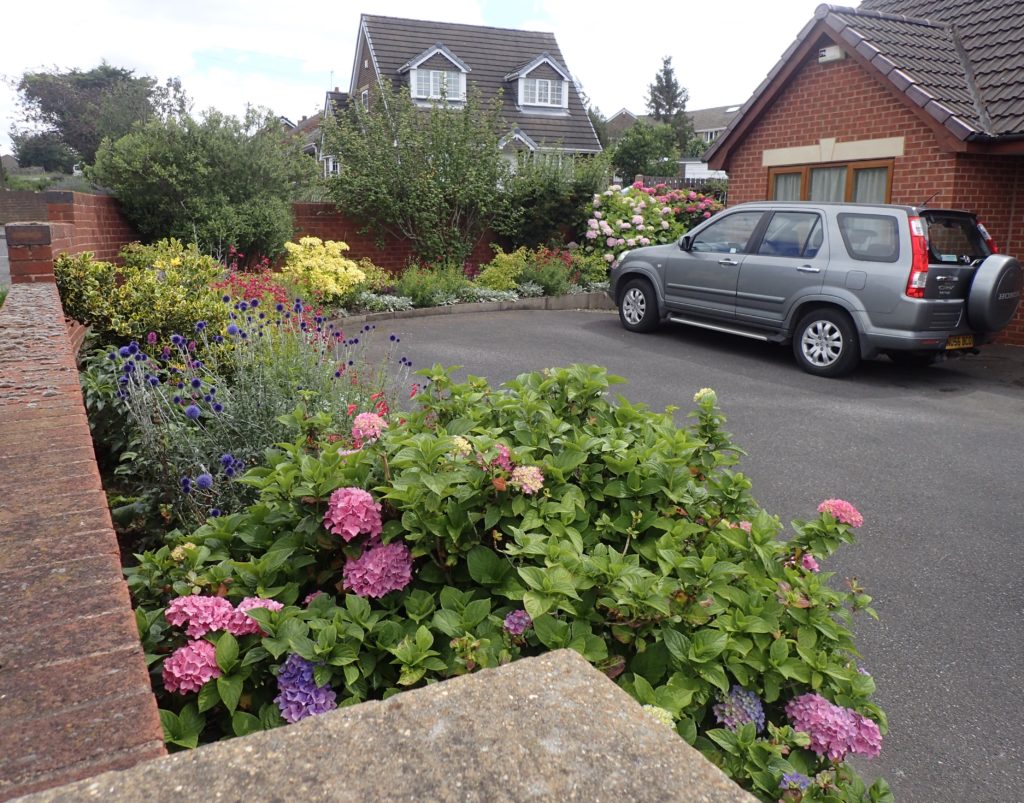
A scheme that came about through a need to overhaul a neglected front border.
Weeds and various plants were removed/killed off over a period of time and the customer selected to retain certain existing plants: 3 no Hydrangea, 1 no variegated Holly, 1 no. white Hebe, 1 no. Pyracantha, 1 no. Choisya ‘Sundance’, 1 no. Ribes and 1 no. Penstemon (Garnet?).
Initially a row of 7 no. equally spaced Cornus ‘Midwinter Fire’ was added to give some rhythm and winter colour. The ground was then carpeted with herbaceous perennials: 5 no. Achillea ‘Summerwine’; 7 no. Cirsium ‘Atropurpurea’, 5 no. Echinops ‘Veitch’s Blue; 9 no. Penstemon Garnet’; 7 no. Perovskia ‘Blue Spire’; 5 no. Phlomis ‘Amazone’; 29 no. Stachys ‘Silver Carpet’ and 5 no. Stachys ‘Hummelo’. In the first autumn after planting 100 no. Allium ‘Purple Sensation’ were spread right throughout the border.
![]()
For the butterflies and the bees

A large garden I manage is as much managed for wildlife as for beauty. The whole site sits on a strongly sloping hillside with a thin layer of topsoil over sandstone. As far as we can tell, the grassland areas have never been fertilised and are therefore largely maintained as species rich wildflower meadows.
Last autumn we planted a small area of close-mown grass adjacent to the meadow with a blaze of the early flowering, (February/March), bulb Crocus tommasinianus, (200 no), so as to provide nectar for early emerging bees. The bulbs are left to self-seed after flowering, with the area then not receiving a first cut until July. (After this it is kept as close-mown grass until the end of the season.)
This year, to further complement the meadows, (and the Crocus lawn), which already attract many insects, we have re-developed a large, adjacent shrub bed as an area to provide season long nectar for butterflies, bees etc. (The existing shrubs were all cleared in preparation a year or so ago and the bed then maintained weed free.)
The first plants to go in were Buddlejas in three clumps of 3 no. plants, (top row, middle three images), these are Buddleja ‘White Profusion’, Buddleja ‘Lochinch’ and Buddleja ‘Royal Red’. Vinca minor (Periwinkle), (top row, extreme left), was planted in a long single row to stabilise the top of the bank where it meets the meadow, (42 no. plants) and Rosmarinus prostratus, (prostrate Rosemary), (top row, extreme right), was similarly planted in a long single row at the bottom of the bed, so as to drape over the edge of a low brick retaining wall, (24 no. plants).
The next plants to go in were 9 no. Lavendula ‘Hidcote’, (bottom row, extreme right), spread throughout the bed.
All the remaining plants are herbaceous perennials, (bottom row from left to right), as follows:-
Achillea ‘Summerwine’ (10 no.); Verbena bonariensis (16 no.); Hylotelephium ‘Matrona’ (10 no.); Knautia macedonia (10 no.); Nepeta ‘Junior Walker’ (9 no.); Origanum laevigatum ‘Herrenhausen’ (10 no); Symphyotrichum ‘Little Carlow’ (top) (10 no.) and Aster x frikartii ‘Monch’ (bottom) (10 no.).
Most of the herbaceous perennials were planted as discreet clumps/drifts but the Verbena was spread throuhgout the bed and will be allowed to naturally self-seed.
We hope the bees and butterflies are very pleased!!
![]()
A back garden for summer

A complementary scheme to the front garden written about below. This garden was designed principally for summer but with some year round interest also. One of the customers loves Lavender so this was a starting point for the design. At the bottom of the garden, next to a seating area, 3 no Hydrangea ‘Lanarth White’, (a delicate lace-cap Hydrangea) and 3 no Phlox ‘Mount Fuji’ are fronted by a short length of Lavendula x stoechas ‘Rocky Road’, (French Lavender), hedge. This small bed is mulched with blue slate chippings. There is then a slight change of level and the main border continues back towards the house. At the change of level, and as a punctuation mark to the border, is a winter flowering Japanese Apricot tree – Prunus mume ‘Beni-chidori’. This small tree has shocking pink flowers bourne on leafless branches in the depths of winter. The border continues with, at the back, 3 no. evergreen Viburnum tinus ‘Eve Price’ fronted by 3 no. Philadelphus ‘Manteau d’Hermine’, (Mock Orange). These are all underplanted with Geranium sylvaticum ‘Album’ and Vinca minor ‘Gertrude Jekyll’ – both ground-cover plants. The English Lavender Lavendula ‘Hidcote’ is dotted throughout this border in groups of threes. Finally at the ‘top’ of the border, nearest to the house lounge windows, are 3 no. Phormium ‘Mauri Sunrise’ underplanted with the contrasting Stachys ‘Silver Carpet’. The whole long border is edge with steel edging. It will be mass planted with a perennial Allium in autumn.
Customer’s reaction: “Thank’s Paul, we love it… Can’t wait to see it spring into action again next year.”
![]()
A front garden for winter
Some customers had a long, much overgrown, Laurel hedge removed from the boundary of their front and back gardens. After a new fence was erected they required some new planting to fill the resultant wide bare borders. Schemes were designed for the front and back gardens so as to have very different characters to each other.
The first scheme is for a winter/early spring garden for the front – something to see, and smell, as people come and go in the bleaker months.
An evergreen back drop of 5 no. winter flowering Mahonia japonica was fronted with 5 no. Cornus ‘Midwinter Fire’ to give a blaze of winter colour. A single Viburnum x burkwoodii was planted at the end of a paved terrace to form a focal point and provide delicious spring scent. The shrubs were then underplanted with a carpet of Waldsteinia ternata, dotted with Helleborus niger, (Christmas Rose). In autumn the bed will be mass planted with the dwarf daffodil Narcissus ‘Hawera’.
By the front door a smaller, rectangular bed was created with a centre piece of a winter flowering Hamamellis ‘Pallida’, (Witch Hazel), underplanted with 6 no sculptural Dryopteris x erythrosora (a fern), all mulched with smart white pebbles. Both beds were edged with steel lawn edging to keep things crisp.
Customer’s reaction; “Thank’s Paul, we love it… Can’t wait to see it spring into action again next year.”
![]()
A quiet place to sit…
A customer had a small area of shrub bed outside her front door that didn’t have much purpose. The area is private, being surrounded by a tall hedge. The idea was to create a small sitting area, using an existing timber bench, surrounded by ‘woodland’ style planting for winter, spring and autumn colour/scent.
After laying some paving stones for access, a paved area for the bench to sit on, spreading new topsoil and positioning some existing stone rocks into sculptural groups, the following plants were used:- by the bench a Japanese Acer tree, Acer palmatum ‘Okushimo’ as a focal point. There is also a small island bed by the customer’s front door and into this an ‘echoing’ Japanese Acer, Acer palmatum ‘Englishtown’ was planted.
Shrubs were then planted in the new bed: 3 no. Cornus ‘Midwinter Fire’ for a blaze of winter colour; Viburnum x juddii for amazing spring scent; an exquisite Corylopis pauciflora and an evergreen Sarcococca confusa for winter scent.
These shrubs were then under-planted with carpets of native Primrose, Persicaria ‘Blackfield’, Pulmonaria ‘Blue Ensign’, the Celandine ‘Brazen Hussy’, (customer’s special request when she learn’t the name of it!!), Astrantia ‘Shaggy’ and Cyclamen hederifolium.
Perhaps some ferns and species bulbs will be added in the future.
![]()
A hot, hot border for high-summer and autumn
Foundation planting all along the base of a house wall approximately 11m long and 1m deep. Designed to give a splash of intense colour from high summer through to autumn. Planted as 48 no. 9cm pot plants at the height of this year’s drought! Thanks to conscientious watering by the customer and myself it has thrived and not a plant was lost. Next year it should be a knock-out!
Plants were: Aster x frikartii ‘Monch’ (6 no.), Helenium ‘The Bishop’ (9no.), Crocosmia ‘Lucifer’ (6 no.), Rudbeckia fulgida ‘Goldsturm’ (12 no.), Verbena bonariensis (6 no.) and Helenium ‘Sahin’s Early Flowerer’ (9 no.).
Cost of plants £240-00. (Additional costs: labour, herbicide and steel lawn/border edging).
![]()
Chakras
I was asked by a lady who practices alternative medicine to help with her garden. I should say at the outset that I personally do not believe in anything ‘other’ so this is not an endorsement but it was an interesting, and challenging, project. The lady is of Indian descent and incorporates ‘chakras’ into her practice.
Chakra is derived from the Sanskrit word for wheel or circle. A chakra is a ‘psychic-energy’ centre in the body found in esoteric Indian religions.
There are seven chakras:- the root chakra, sacral, solar, heart, throat, third-eye and crown. Each chakra is associated with a set of characteristics, for example, the root chakra, located at the base of the spine, is associated with security, safety, survival, basic needs such as food, sleep, shelter, self-preservation, etc., physicality, grounding and foundation. By contrast the crown chakra, located at the top of the head, is associated with consciousness, awareness of higher consciousness, wisdom and of what is sacred, communion with higher states of consciousness, ecstasy and bliss etc. Information on the other five chakras is plentiful on the internet!
Each chakra is also associated with a colour:-
root = red
sacral = orange
solar – yellow
heart = green
throat = blue
3rd eye = indigo
crown = violet/white
The lady has a treatment centre in the centre of her garden. I surrounded this with seven bowls each planted up with a separate chakra colour. In a nearby raised planter I planted a rainbow of chakra colours from red through to violet.
The top line in the image above shows the seven plants in the bowls; the bottom line the plants in the planter. The plants are, (top line): Sedum purdyi ‘Red Cauli’, Geum ‘Totally Tangerine’, Achillea ‘Coronation Gold’, Achillea ‘Coronation Gold’, Alchemilla mollis, Penstemon ‘Catherine de la Mare’ and Salvia verticillata ‘Purple Rain’. The plants in the bottom line are: Crocosmia ‘Lucifer’, Hemerocallis ‘Burning Daylight’, Rudbeckia fulgida ‘Goldsturm’, Euphorbia amygdaloides var. Robbiae, Polenium ‘Stairway to Heaven’, Scabiosa ‘Butterfly Blue’ and Iris ‘Black Swan’.
![]()
Design and development – a touch of Zen
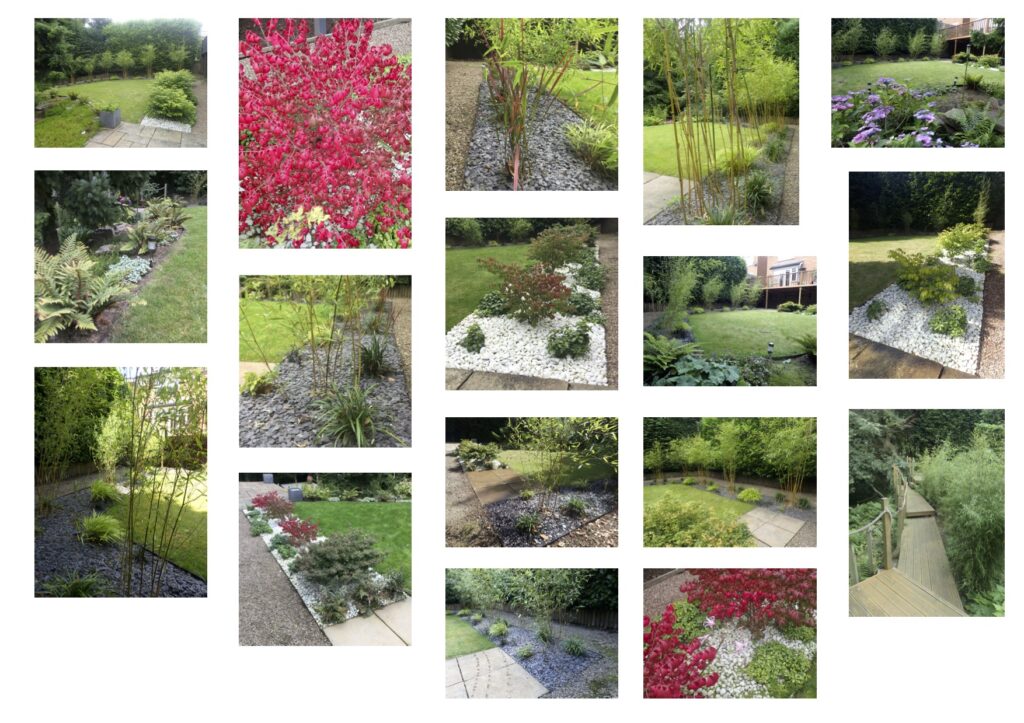
Two new beds created to redesign part of a lawned back garden after the removal of an unused trampoline. The garden is looked down on from a veranda. The customers both have more contemporary than traditional taste so we took a sort of Zen minimalism as our initial inspiration.
The larger of the two beds is an L-shaped bed running down the side and back of the garden but set back from a conifer hedge to allow for maintenance of the hedge. This bed was planted with: Phyllostachys aureosuculata f. spectabils, (7 no.), (a yellow stemmed bamboo), planted as an evenly spaced avenue to give a kind of cloister effect; Liriope muscari, (14 no.), (Japanese Mondo grass); Ophiopogon planiscarpus ‘Black Dragon’, (13 no.), (Japanese black grass); Hakonechloa macra ‘Aureola’, (7 no.), (a golden Japanese grass); Imperata cylindrica ‘Red Baron’, (6 no.), (Japanese Blood grass). All the grasses are used as groundcover planting under the bamboos. The bed was mulched with black, angular, slate.
The second smaller bed is at the front of the garden. (The left hand side of the garden is formed by an existing rockery sloping down to a stream. This bed has already had Japanese Shield ferns and black stemmed bamboos added to it as a transition from the ‘Zen’ borders down to a more natural, waterside area.) This was planted with Acer palmatum ‘Little Princess’, (1 no.), (Japanese Maple tree), a single plant planted next to an entrance area of paving; Euonymus alatus ‘Compactus’, (3 no.), (dwarf Spindle tree), planted in a short avenue in line with the Acer; Pachysandra terminalis ‘Green Carpet’, (12 no.), evergreen groundcover beneath the Spindle trees; Epimedium x youngianum ‘Niveum’, (4 no.), groundcover planting to the Acer; Athyrium niponicum var, pictum, (3 no.), (Japanese painted fern), planted in a row of three next to the garden’s paved entrance; Nerine bowdenii, these bulbs were planted in three clumps between the Acer and Spindle trees to add an intense splash of Autumn colour. This bed was mulched with white, rounded, pebbles.
Both beds have been edged with steel edging to keep edges sharp and crisp. Between the two beds there are 6 no. paving slabs to provide an entrance to the lawned area within the planted beds.
Total number of plants used: 70 no. Total cost of plant material: £670. Cost does not include for steel edging, paving, compost, ‘Rootgrow’, mulches, Nerines or labour.
![]()
Design and development – a contemporary front garden
The above photos show before and after the redevelopment of a small front garden. The gardens at this property are maintained on a fortnightly basis and the works were carried out over a number of weeks as part of the routine visits.
The original inspiration for the scheme was a Mediterranean feel – this was requested by the customer. A curved path with Thyme interplanting – seen at the back of the photos – had previously been installed and we wanted to build on the Thyme with Lavenders and other herbs.
Initial works included the removal of the large conifer, (by another), and other plants and a small area of lawn. Plants retained were a Crataegus prunifolia tree, (out of picture), and a prostrate Juniper. Three Helicrhysum (curry plants) were potted up and re-planted, after growing on, as part of the scheme.
A design was then developed. The design process, outlined in the images below, involved preparation of a measured survey; the production of some initial concept options; refinement of the chosen design; various options for plants and finally the preparation of a planting plan.
The scheme evolved to have a back ‘hedge’ of Sanoltina incana (23 no.) then four ‘waves’ of Hebe ‘Purple Princess (9 no.), a dwarf Perovskia ‘Little Spire’ (9 no.) and purple (‘Hidcote’) and white (‘Arctic Snow’) lavenders (9 no. of each). Three Phormium ‘Evening Glow’ are interplanted between the waves.
The whole scheme was then given a mulch of beach pebbles.
Costs for the scheme, not including the design process or labour, were £65 for tree removal, £340 for plants and £200 for beach pebbles.
Edit: two years later…
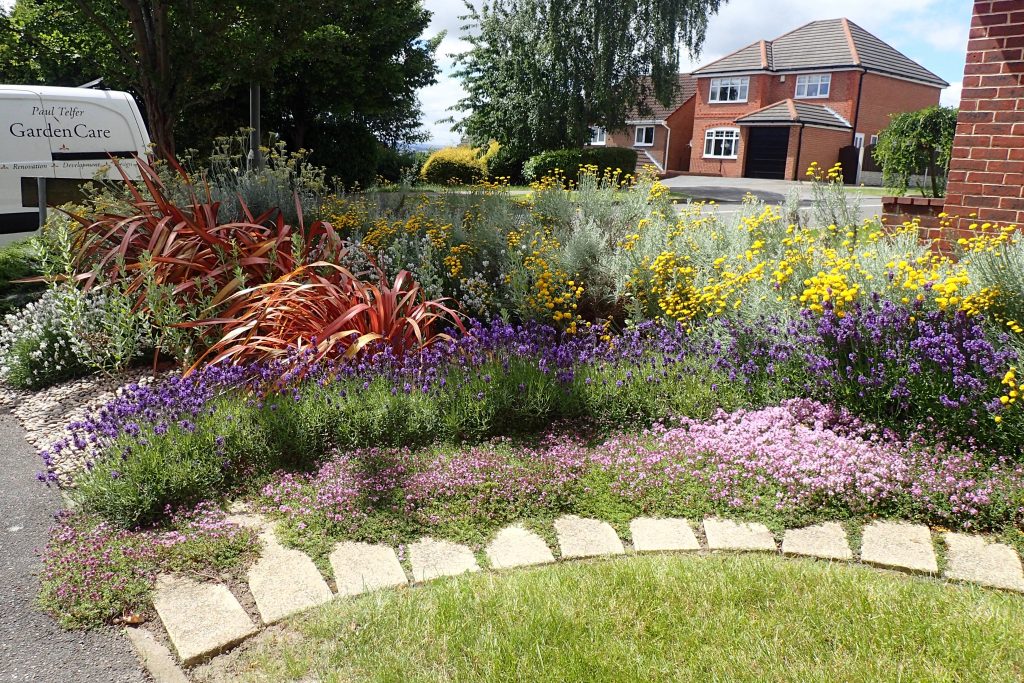
![]()
Development – scheme for a hedge bottom
A customer wanted a scheme for a small rockery front garden beneath an established beech hedge. Inspired by typical hedge bottom plants such as foxgloves and ferns, I chose plants that were cultivars of native plants, that would survive in the dry soil conditions and that would provide the requested ground-cover. (I have suggested that in Autumn we mass plant the dwarf Narcissus ‘Hawera’ and a species Tulip to provide Spring colour.)
From left to right:- Lamium maculata ‘Beacon Silver’ – a dead-nettle, excellent ground-cover; Primula vulgaris – native primrose; Digitalis ‘Dalmation Purple’ – a foxglove cultivar; Thelypteris decursive-pinnata, the wood fern; Pulmonaria ‘Trevi Fountain’ – a lungwort, good ground-cover; Ranunculus ‘Brazen Hussy’ – a cultivated celandine, good ground cover; Vinca minor ‘Atropurpurea’ – periwinkle variety, excellent ground-cover; Convallaria majalis – lily-of-the-valley, again, good ground-cover.
All plants were planted in threes.
Total number of plants – 27 no. Cost of plants – £115.
(Bulbs not costed. Labour not included.)
![]()
Development – a river of daffodils
(Ok Narcissus if you want to be posh!)
A scheme to add a changing ‘river’ of daffodils, with plants in flower from late February through to mid-April. 100 no. each of six varieties of Narcissus were planted down the side of a long driveway in blocks of the individual varieties.
From left to right:- Narcissus ‘February Gold’; Narcissus ‘Hawera’; Narcissus ‘Ice Wings’; Narcissus ‘Jenny’; Narcissus ‘Pipit’; Narcissus ‘Petrel’.
Total no. of bulbs – 600 no. Total cost of bulbs – £300.
![]()
Development – adding to an existing herbaceous border
A scheme to add some colour to a very long herbaceous border. The border has many established shrubs/plants but has been planted up over the years in a rather haphazard manner and lacks any strong visual structure. Last year an avenue of seven no. Crab Apple tree was planted to start to address this. The latest planting adds colour, (the owner likes strong colours), and further structure through repeat planting.
From left to right:- Spiraea japonica ‘Shirobana’ (5 no.); Allium sphaerocephalon (4 no.); Agapanthus africans ‘Charlotte’ (5 no.); Monarda ‘Garden View Scarlet’ (3 no.); Phlox paniculata ‘Purple Eye Flame’ (3 no.); Agastache ‘Blue Fortune’ (3no.).
Total no. of plants – 23 no.
Total cost of plant material – £200.
![]()
Development – a blue border
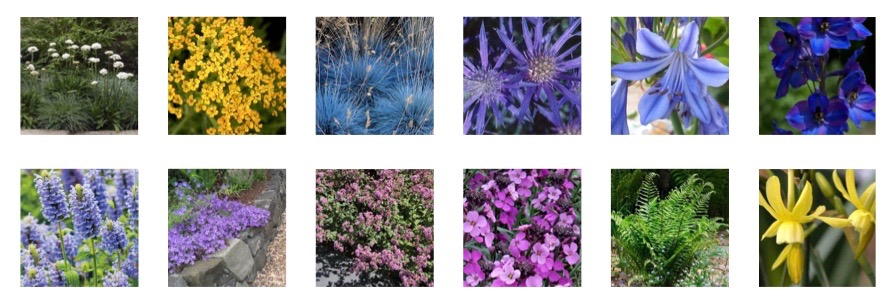
A new border in an established garden. The client asked for blue flowering perennials but was otherwise very open on plant choice. The new bed completes a circuit of planting around a central lawn and also ties a ‘wilder’ bed at a distance from a patio area to more floriferous borders near this seating/dining place. The bed also provides a new view through a window in the ‘garden room’ in the adjacent house.
Agapanthus and dwarf Delphiniums, both with an intense blue colour, were chosen to which softer blues/mauves/rose colours were added with splashes of white and yellow for contrast. Ferns were added to tie in with the ‘wild’ border. Narcissus bulbs were added for Spring colour and the bed was top-dressed with a thick layer of gravel to set off the plants, provide some slug protection and match a gravel found elsewhere in the garden.
Customer reaction:- “I love the flowers you have picked and can’t wait to see them in their full glory.”
Top row, from left to right:- Armeria ‘Ballerina White’ – a white thrift (3 no.); Achillea ‘Marmalade – a yarrow (3 no.); Festuca glauca ‘Elijah Blue’ – a blue grass (5 no.); Eryngium bourgatii ‘Picos Blue’ (3 no.); Agapanthus africanus ‘Blue Giant’ (1 no.); Delphinium excalibur ‘Dark Blue Black’ – a dwarf delphinium, (3 no.).Bottom row, from left to right:-Nepeta nervosa ‘Blue Moon’ (3 no.); Campanula portenschiangiana (3no); Origanum ‘Rosenkupple’ (3 no); Erisynum ‘Bowles Mauve’ (3 no.) – a perennial wallflower; Dryopteris affinis ‘Cristata the King’ – a fern; Narcissus ‘Hawera’ (70 no.).
Total no. of plants – 33 no. Cost £215. No. of bulbs – 70 no. Cost – £30. Total cost of plant material – £245
Cost of gravel mulch – £105
Total scheme cost (excluding labour) – £350
![]()
Development – ferns, ground-cover and bulbs
A simple scheme to edge a newly shaped lawn. The lawn has been edged with a sheet steel product to keep it crisp and angular; the planting is intended to complement this sharp effect.
A line of 7 no. equally spaced, architectural ferns set within simple ground-cover. The ground-cover is underplanted with elegant Spring bulbs. More dramatic red tulips have been planted into two cube shape planters on an adjacent stone flagged terrace.
Customer’s reaction:- “The ferns look outstanding – I really like them. We are really happy about how things are looking.”
From left to right:- Polystichum polyblepharum; Crocus ‘Vanguard’; Narcissus hawera; Tulipa ‘Typhoon’; Lamium maculatum ‘Silver Beacon’.
No. of plants – 13. No. of bulbs – 330.
Total price of plant material – £200.
![]()
Development – adding colour to a back garden
A suburban back garden with established plants. The customer’s brief was to add back some theatre and colour. A decked seating area has had climbing plants added to green-up the timber fences on two sides of the decking.
Customer’s reaction:- “The plants look fantastic by the way.”
Top row – Caryopteris ‘Heavenly Blue’; Echinacea purpurea ‘Rubinglow’; Agapanthus africanus ‘Charlotte’; Santolina virens; Lavendula angustifolia.
Bottom row – Aster x frikartii ‘Monch’; Jasminum officinale ‘Sunbeam’; Perovskia ‘ Blue Spire’; Parthenocissus veitchii; Clematis montana ‘Wilsonii’; Heuchera ‘Sugar Frosting’.
Total cost of plant material – £200.
![]()
Development – adding colour to a front garden
A small front garden with many established/mature plants but with some gaps and a request for an injection of colour.
Customer’s reaction:- “The plants look lovely. Fills up the spaces really well.”
Top row:- Nepeta ‘Junior Walker’; Origanum ‘Rosen-keppel’; Verbenna bonariensis; Achillea ‘Marmalade’; Heuchera ‘Melting Fire’.
Bottom row:- Digitalis ‘Illumination Raspberry’; Geranium ‘Blue Sunrise’; Lavendula angustifolia; Hebe ‘Margaret; Lythrum salicaria ‘Robert’.
Thirty plants in total were planted – three of each. Total cost of plant material – £200.
![]()
Development – wild flowers for a wetland meadow
A scheme for a small area of wetland. The area is at the bottom of a sloping suburban garden, next to a stream and backed by a beautiful bluebell wood. However, it has always been a problem for its owners, in terms of what to plant there, because of severe annual flooding. The owners have now been persuaded to work with nature, rather than fight it. The area will now be managed as a wetland meadow by carefully controlling unwanted species and encouraging desired ones. To help accelerate the process 150 suitable wildflower plugs have been planted. All plants are true wildflowers of UK provenance. From left to right:
Water avens; Devil’s Bit Scabious; Meadowsweet; Primrose; Purple Loosestife; Ragged Robin and Sneezewort.
Cost of plant material: £185.
![]()
Development – wild flowers for a woodland garden
A scheme to under-plant areas of woodland either side of a entrance driveway with bold sheets of spring colour. Plants were either ‘in-the-green’ bulbs or plugs. All plants were true wild flowers of British provenance.
From left to right: Primula vulgaris (native Primrose). This is planted either side of the property’s entrance gates under two established Yew trees. Anemone nemorosa (Wood Anemone). Planted on one side of the driveway just after entering the property. Hyacinthoides non-scripta (native Bluebell). Planted on the other side of the drive. Galanthus nivalis (Snowdrop). Planted further down from the blue bells. Narcissus pseudonarcissus (Wild Daffodil). This is planted on a large rockery elsewhere in the garden.
Total number of plants – 510. Total cost of plant material – £335.
![]()
Development – a colourful coppice
This scheme creates a small area of ‘woodland coppice’. The area planted up is in a garden with a strong emphasis on management for wildlife and is adjacent to existing woodland on a neighbouring property. The scheme makes use of an otherwise difficult to maintain steep bank. It seeks to be of value as wildlife habitat yet also have strong ornamental value, especially in the winter months.
From left to right: Sarcococca humilis (Christmas box), this forms a low evergreen ‘hedge’ adjacent to a paved area and gives the area a strong boundary. Christmas box has a beautiful scent in winter. Cornus alba sibirica (Siberian dogwood). This has bright red stems in winter. Cornus ‘Flaviramea’ (Yellow stemmed dogwood). Viburnum opulus (Guelder rose). Beautiful white flowers in spring; red berries in autumn. Corylus avellana (Hazel). The Hazel, Dogwoods and Guelder rose will all be managed by coppicing.
Plants were a mixture of container grown and bare-root stock. Number of plants – 19. Cost of plant material – £70.
![]()
Development – Weavers’ Cottages part two
The second part of the scheme at the weavers’ cottages. This is for the bed on the opposite boundary to the first bed planted up as described below. The second scheme reflects the owner’s business selling outdoor clothing wear for children, and also the location of the cottages, through its plant choice. The bed is to the left hand side of a long cobbled path which rises up from a lane, (after a small flight of steps), to the front door. The slope of the bed was first terraced into four rectangular compartments using stone blocks found in the garden. The bed is backed by an existing holly and privet hedge.
Each compartment was filled with a block of a single species like a block of colour in a paint palette. Adjacent to each of the three stone ‘walls’, at the changes of level, three specimen shrubs will be planted.
From left to right the images show: Primula vulgaris, (native Primrose). This was planted by the client in a clump just by the entrance gate to the garden to make a splash of welcoming colour. Blechnum spicant, (Hard Fern). Erica carnea ‘Myretoun Ruby’. There are two blocks of this winter heath separated by the ferns. The aim was to include two intense blocks of winter colour. Dryopteris erythrosora, (Japanese Shield Fern). Euonymus alatus ‘Compactus’, (Compact Winged Spindle Tree). These have yet to be planted at the time of writing but will form the three specimen plants. This slow growing small tree/shrub has several interesting features: winged corky bark; intense red autumn colour, small flowers followed by purplish-red berries, which split to reveal seeds.
Number of plants planted to date, (not including Spindle Trees and Primroses) – 64. Cost of plants – £200.
![]()
Development – Weavers’ Cottages part one

The first part of a scheme for a pair of old weavers’ cottages, (part of a terrace of cottages rising up a hill). This is the planting for one of three beds, being one of the side beds to the garden. The bed was essentially bare but a holly, (now toparied into a cube shape), a hydrangea and a couple of paonies have been retained. To this have been added three different areas of ground-cover each with highlight, specimen plants and mass bulbs. The planting is designed to look its best through winter and early spring but some bulbs are included for late summer/early autumn.
Top row from left to right: Cornus ‘Mid-Winter Fire’, grown for its outstanding winter stem colour; Sarcoccoca humilis included for the beautiful winter fragrance of its tiny white flowers; Daphne mezereum, again included for stunning winter fragrance; Bergenia cordifolia ‘Bressingham Ruby’, planted by a door to the cottages as a ‘full-stop’ plant.
Middle row, left to right: Epimedium sulphureum, ground-cover; Vinca ‘Gertrude Jeykll’, groundcover; Waldsteinata ternata, the last of the three ground-cover plants; Colchicum autumnale, the first of three bulbs mass planted for strong seasonal effects.
Bottom row from left to right: Narcissus ‘Thalia’, the main bulb included in the scheme; Erythronium, the final bulb included in the bed; Pachysandra terminalis, this is planted separately as ground-cover at the foot of the front boundary stone wall to the cottages along a lane; Galanthus nivalis, snowdrops have been mass planted amongst the Pachysandra.
Number of plants planted – 70. Number of bulbs planted, (to date) – 80. Cost of plants and bulbs, (to date) – £370.
![]()
Development – a white theme for a shady border

A mostly white scheme for a border at the edge of a garden which is predominantly in shade. White is a colour which glows in shade and twilight. From left to right the plants are:
Vinca minor ‘Gertrude Jeykll’; Alchemilla mollis; Geranium sanguineum album; Hydrangea ‘Lanarth’ and Bergenia ‘Silberlicht’. To these will be added mass Narcissi bulbs for spring colour.
![]()
Development – a border for Sylvia
The customer for this planting scheme has a small rectangular border looked directly onto from her conservatory. The brief was to revitalise the bed so as to provide summer interest for viewing when sitting in the conservatory. All but a few plants were removed leaving just a backdrop of winter jasmine trained against a fence, a hardy geranium, (to be divided this autumn), and a hellebore. A range of herbaceous perennials was then introduced together with bulbs and, in summer, pots of annual tobacco plants will be placed on a paved area in front of the bed to provide strong fragrance. From left to right, starting with the top line, the plants are:
Aster ‘Monch’; Polystichum ‘Jade’; Digitalis ‘Carillion’; Achillea ‘Moonshine’; Kniphofia ‘Wrexham Buttercup’; Astrantia ‘Star of Billion’; Anenome ‘Honorine de Joubert’; Echinacea ‘Virgin’; Narcissus ‘Hawera’; Narcissus ‘Ice Wings’; Nicotiana alata.
The number of plants planted was 27. The number of bulbs planted is 30. Total cost of plant material, (excluding proposed further bulb planting and annuals), is £220.
![]()
Development – late summer colour
A simple planting scheme to introduce late summer colour into a steeply terraced garden. In time, each terrace will be treated with a different palette of plants to celebrate a different season of the year. From left to right: Heuchera ‘Chocolate Ruffles’; all the plants are set in a mulch of grey/blue slate chippings which shows them off really well; Persicaria ‘Blackfield’; Rudbeckia ‘Goldsturm’ and Potentilla ‘Monarch’s Velvet.
Number of plants planted – ten. Cost of plant material £85.
![]()
Maintenance – wildflower meadows
The owner of this garden wants to enhance its wildlife value. As an experiment therefore, two areas of grass on steep banks were left uncut this summer as wildflower meadows. The hope is that in time, and with careful management, they will become species rich. The prospects for this are helped by the fact that the grass is on very thin soils and doesn’t seem to have been ‘improved’ with fertilizer at any time. (The garden was originally farmland.) Species recorded this year have included bluebells, knapweeds, yarrow, bird’s foot trefoil, ox-eye daisy and scabious and the areas have been very popular with butterflies, bees and other insects.
For the sake of neatness an area at the bottom of the first meadow, in front of the house and along the driveway, was kept close cut. This can be seen in the first photo. A similar technique was used in a meadow at the back of the property. The few weeds that appeared in the meadows over summer, mainly ragwort and thistles, were removed by hand-pulling.
In September both areas were strimmed, the arisings raked into heaps and, after a week of drying out, raked up and removed. (This helps to keep the areas nutrient poor, which is good for the wildflowers we want to encourage and less good for vigorous grass species, thistles and other unwanted ‘weeds’.) The front meadow was then mown. This can be seen in the second photo. (The back meadow is on a slope too steep to be safely mown so this was only strimmed.
A promising start!
![]()
Renovation – a neglected garden
This garden had become somewhat overgrown after a period when the owner was unable to work on it. The plant beds had become infested with couch grass, nettles and other weeds. Lawns had areas of long grass where they hadn’t been cut. Shrubs needed pruning. Paved areas had become weedy.
Work included: progressively strimming the long grass back until it could be cut as a lawn again; hand weeding plant beds and borders, and forking through the plant beds to remove as much couch as possible; transplanting and saving plants wherever possible; formative pruning of trees, shrubs, climbers and roses; minor planting; putting up wire supports for climbing plants; weeding the drive, paths and patio areas; re-use of existing stone for edging; re-siting a compost bin; general clear up and neat stacking of existing materials; the removal of rubbish to tip, (with the owner’s assistance). Total time spent: 30 hours.
![]()
Renovation – an over-mature garden
The owners of this garden are very busy people with many commitments. As a result a once beautiful garden was suffering from some neglect. Some shrubs, such as snowberry, had got out of hand and brambles were establishing themselves in various places. Fruit trees and bushes needed significant pruning.
Work included: clearance of invasive shrubs such as snowberry; formative pruning of trees and shrubs across the garden; pruning and winter wash of fruit trees and bushes; removal of a derelict fruit cage frame; construction of a leaf compost bin; the removal of significant amounts of green waste to tip, (with the owner’s assistance). In spring, plants susceptible to silverleaf disease, such as plum and cherry trees, will be pruned to complete the renovation. Total time spent (to date): 50 hours.


